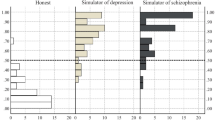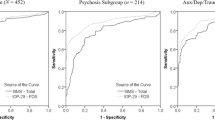Abstract
The aim of the present study was to investigate the efficacy of the Structured Inventory of Malingered Symptomatology (SIMS) to detect feigned psychosis in naïve, informed, and coached participants. Sixty undergraduate students were administered the SIMS and a number of filler questionnaires and asked to fill out the questionnaire honestly (controls; n = 15) or instructed to malinger psychosis because they were standing trial for a serious offense. Before they completed the SIMS, instructed malingerers either received no further information (naïve malingerers; n = 15), some information about psychotic symptoms (informed malingerers; n = 15), or some information about psychosis and a warning not to exaggerate symptoms (coached malingerers; n = 15). Even in the group of coached malingerers, the SIMS had acceptable sensitivity and specificity rates. These findings suggest that the SIMS may be of value in forensic assessments.
Similar content being viewed by others
References
Abrahamsen, D. (1985). Confessions of the Son of Sam. New York: Columbia University Press.
Beaber, R. J., Marston, A., Michelli, J., & Mills, M. J. (1985). A brief test for measuring malingering in schizophrenic individuals. American Journal of Psychiatry, 142, 1478–1481.
Dunn, T. M., Shear, P. K., Howe, S., & Ris, D. M. (2003). Detecting neuropsychological malingering: Effects of coaching and information. Archives of Clinical Neuropsychology, 18, 121–134.
Edens, J. F., Otto, R. K., & Dwyer, T. (1999). Utility of the Structured Inventory of Malingered Symptomatology in identifying persons motivated to malinger psychopathology. Journal of the American Academy of Psychiatry and the Law, 27, 387–396.
Fauteck, P. K. (1995). Detecting the malingering of psychosis in offenders: No easy solutions. Criminal Justice and Behavior, 22, 3–18.
Hilsabeck, R. C., LeCompte, D. C., Marks, A. R., & Grafman, J. (2001). The Word Completion Memory Test (WCMT): A new test to detect malingered memory deficits. Archives of Clinical Neuropsychology, 16, 669–677.
Jaffe, M. E., & Sharma, K. K. (1998). Malingering uncommon psychiatric symptoms among defendants charged under California’s “Three Strikes and You’re Out” Law. Journal of Forensic Science, 43, 549–555.
Lewis, J. L., Simcox, A. M., & Berry, D. T. R. (2002). Screening for feigned psychiatric symptoms in a forensic sample by using the MMPI-2 and the Structured Inventory of Malingered Symptomatology. Psychological Assessment, 14, 170–176.
Merckelbach, H., & Smith, G. P. (2003). Diagnostic accuracy of the Structured Inventory of Malingered Symptomatology (SIMS) in detecting instructed malingering. Archives of Clinical Neuropsychology, 18, 145–152.
Powell, M. R., Gfeller, J. D., Hendricks, B. L., & Sharland, M. (2004). Detecting symptom— and test—coached simulators with the Test of Memory Malingering. Archives of Clinical Neuropsychology, 19, 693–702.
Resnick, P. J. (1999). The detection of malingered psychosis. The Psychiatric Clinics of North America, 22, 159–172.
Rogers, R., Harrell, E. H., & Liff, C. D. (1993). Feigning neuropsychological impairment: A critical review of methodological and clinical considerations. Clinical Psychology Review, 13, 255–274.
Rogers, R., Hinds, J. D., & Sewell, K. W. (1996). Feigning psychopathology among adolescent offenders: Validation of the SIRS, MMPI-A, and SIMS. Journal of Personality Assessment, 67, 244–257.
Rogers, R., & Shuman, D. W. (2000). Conducting insanity evaluations, 2nd ed. New York: Guilford Press.
Rosenfeld, B., Sands, S. A., & Van Gorp, W. G. (2000). Have we forgotten the base rate problem? Archives of Clinical Neuropsychology, 15, 349–359.
Rosenhan, D. (1973). On being sane in insane places. Science, 172, 250–258.
Smith, G. P. (1997). Assessment of malingering with self-report instruments. In R. Rogers (Ed.), Clinical assessment of malingering and deception, 2nd ed. (pp. 351–370). New York: Guilford Press.
Smith, G. P., & Burger, G. K. (1997). Detection of malingering: Validation of the Structured Inventory of Malingered Symptomatology. Journal of the American Academy of Psychiatry and the Law, 25, 183–189.
Spitzer, R. L. (1975). On pseudoscience in science, logic in remission, and psychiatric diagnosis: A critique on Rosenhan’s “On being sane in insane places.” Journal of Abnormal Psychology, 84, 442–452.
Youngjohn, J. R. (1995). Confirmed attorney coaching prior to neuropsychological evaluation. Assessment, 2, 279–283.
Youngjohn, J. R., Lees-Haley, P. R., & Binder, L. M. (1999). Comment: Warning malingerers produces more sophisticated malingering. Archives of Clinical Neuropsychology, 14, 511–515.
Author information
Authors and Affiliations
Corresponding author
Rights and permissions
About this article
Cite this article
Jelicic, M., Hessels, A. & Merckelbach, H. Detection of Feigned Psychosis with the Structured Inventory of Malingered Symptomatology (SIMS): A Study of Coached and Uncoached Simulators. J Psychopathol Behav Assess 28, 19–22 (2006). https://doi.org/10.1007/s10862-006-4535-0
Accepted:
Issue Date:
DOI: https://doi.org/10.1007/s10862-006-4535-0




